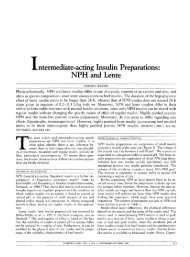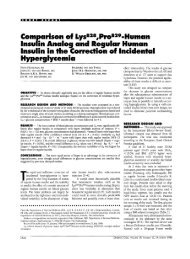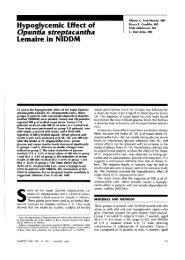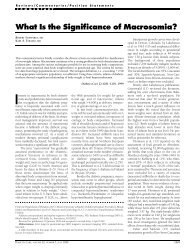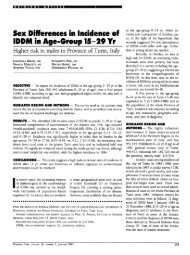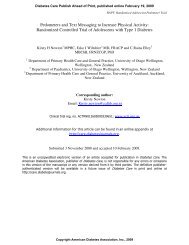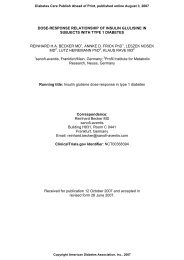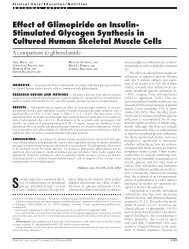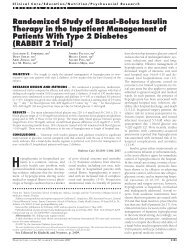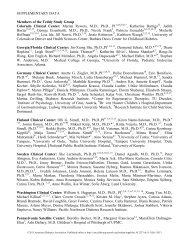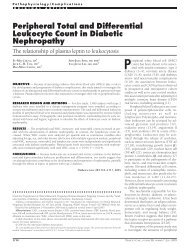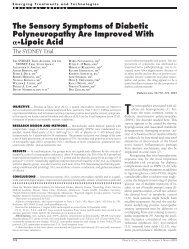A 8-year Prospective Analysis of 1074 Type 2 ... - Diabetes Care
A 8-year Prospective Analysis of 1074 Type 2 ... - Diabetes Care
A 8-year Prospective Analysis of 1074 Type 2 ... - Diabetes Care
You also want an ePaper? Increase the reach of your titles
YUMPU automatically turns print PDFs into web optimized ePapers that Google loves.
<strong>Diabetes</strong> <strong>Care</strong> Publish Ahead <strong>of</strong> Print, published online August 20, 2008<br />
Aldose Reductase Genotypes and Cardio-Renal Complications – A 8-<strong>year</strong><br />
<strong>Prospective</strong> <strong>Analysis</strong> <strong>of</strong> <strong>1074</strong> <strong>Type</strong> 2 Diabetic Patients<br />
* 1 Wing-Yee So, MBChB, FRCP, * 1 Ying Wang PhD, 1 Maggie CY Ng, BSc, PhD, 1 Xilin Yang,<br />
PhD, 1 Ronald CW Ma, MBBCHIR, MRCP, 1 Vincent Lam, BSc MPhil, 1,2 Alice PS Kong,<br />
MBChB, FRCP, 1,2,.3 Peter CY Tong, PhD, FRCP, 1,2,3 Juliana CN Chan, MD, FRCP,<br />
1 Department <strong>of</strong> Medicine & Therapeutics, 2 Li Ka Shing Institute <strong>of</strong> Health Sciences, 3 Hong<br />
Kong Institute <strong>of</strong> <strong>Diabetes</strong> and Obesity, The Chinese University <strong>of</strong> Hong Kong, The Prince <strong>of</strong><br />
Wales Hospital, Shatin, Hong Kong SAR, CHINA<br />
*WY and WYS contributed equally to the manuscript<br />
Corresponding Author:<br />
Pr<strong>of</strong>essor Juliana CN Chan,<br />
E-mail address: jchan@cuhk.edu.hk<br />
Submitted 12 April 2008 and accepted 07 August 2008.<br />
This is an uncopyedited electronic version <strong>of</strong> an article accepted for publication in <strong>Diabetes</strong> <strong>Care</strong>. The<br />
American <strong>Diabetes</strong> Association, publisher <strong>of</strong> <strong>Diabetes</strong> <strong>Care</strong>, is not responsible for any errors or omissions<br />
in this version <strong>of</strong> the manuscript or any version derived from it by third parties. The definitive publisherauthenticated<br />
version will be available in a future issue <strong>of</strong> <strong>Diabetes</strong> <strong>Care</strong> in print and online at<br />
http://care.diabetesjournals.org.<br />
Page 1 <strong>of</strong> 15<br />
Copyright American <strong>Diabetes</strong> Association, Inc., 2008
Background: We reported the independent risk association <strong>of</strong> type 2 diabetic nephropathy with<br />
z-2 allele <strong>of</strong> the 5’−(CA)n microsatellite and C−106T promoter polymorphisms <strong>of</strong> the aldose<br />
reductase (ALR2) gene using case-control design. In this expanded cohort, we examined their<br />
predictive roles on new onset <strong>of</strong> cardio-renal complications using a prospective design.<br />
Methods: In this 8-<strong>year</strong> prospective cohort <strong>of</strong> <strong>1074</strong> type 2 diabetic patients (59% male, median<br />
age: 61 <strong>year</strong>s; disease duration: 7 <strong>year</strong>s) with an observation period <strong>of</strong> 8592 person-<strong>year</strong>s, none<br />
had clinical evidence <strong>of</strong> coronary heart disease (CHD) or chronic kidney disease (CKD) at<br />
recruitment. Renal endpoint was defined as new onset <strong>of</strong> estimated glomerular filtration rate<br />
(eGFR) < 60 min/min/1.72m 2 , hospitalizations with dialysis or death due to renal disease while<br />
CHD was defined as hospitalizations with myocardial infarction, ischemic heart disease or<br />
related deaths.<br />
Results: After controlling for baseline risk factors and use <strong>of</strong> medications, ALR2 z-2 allele <strong>of</strong><br />
(CA)n microsatellite carriers had increased risk <strong>of</strong> renal [hazard ratio, 1.53; 95 percent<br />
confidence interval, (1.14-2.05) p=0.005] or combined cardio-renal endpoints [1.31 (1.01-1.72)<br />
p=0.047]. Carriers <strong>of</strong> ALR2 C−106T polymorphism also had increased risk <strong>of</strong> renal [1.54(1.15-<br />
2.07) p=0.004] and cardio-renal endpoint [1.49 (1.14-1.95) p=0.004]. Compared to non-carriers,<br />
patients with 2 risk conferring genotypes had 2-fold increased risk <strong>of</strong> renal [2.41 (1.57-3.70)<br />
p
C<br />
ardiovascular diseases (CVD)<br />
and end stage renal disease<br />
(ESRD) are main causes <strong>of</strong><br />
mortality and morbidity in diabetic patients.<br />
The onset <strong>of</strong> chronic kidney disease (CKD)<br />
markedly increases risk <strong>of</strong> CVD due to further<br />
perturbation in metabolic milieu and vascular<br />
homeostasis (1). In type 2 diabetes, control <strong>of</strong><br />
hyperglycemia reduces proteinuria and rate <strong>of</strong><br />
decline in renal function (2). In type 1<br />
diabetes, established renal lesions were<br />
reversed with restoration <strong>of</strong> normoglycemia<br />
after pancreatic transplantation (3). Aldose<br />
reductase (ALR2) converts glucose to sorbitol<br />
especially under hyperglycemic condition.<br />
Accumulation <strong>of</strong> sorbitol can lead to<br />
increased oxidative and osmotic stresses<br />
causing cataract, microvascular complications<br />
and myocardial ischemic injury (4).<br />
In a case-control cohort consisting <strong>of</strong><br />
92 Chinese type 2 diabetic patients without<br />
nephropathy despite long disease duration and<br />
121 patients with both retinopathy and<br />
nephropathy, the z-2 allele <strong>of</strong> 5’−(CA)n<br />
microsatellite and promoter C−106T<br />
polymorphisms <strong>of</strong> ALR2 independently<br />
conferred risk <strong>of</strong> diabetic nephropathy (5). In<br />
this expanded consecutive cohort <strong>of</strong> <strong>1074</strong><br />
type 2 diabetic patients with documentation <strong>of</strong><br />
risk factors, complications and clinical<br />
outcomes, we examined the independent and<br />
additive effects <strong>of</strong> these 2 polymorphisms <strong>of</strong><br />
ALR2 gene on cardio-renal endpoints after an<br />
8-<strong>year</strong> observational period.<br />
METHODS<br />
Hong Kong <strong>Diabetes</strong> Registry—This<br />
Registry was established in 1995 as part <strong>of</strong> a<br />
quality improvement program based on the<br />
European DIABCARE protocol and<br />
accompanied by a DNA bank donated by<br />
patients with written informed consent. Using<br />
this Registry, we have reported the use <strong>of</strong><br />
clinical and biochemical markers to predict<br />
cardio-renal complications (6) (7) (8). The<br />
Page 3 <strong>of</strong> 15<br />
study was approved by the Chinese<br />
University <strong>of</strong> Hong Kong Clinical Research<br />
Ethics Committee. The recruitment methods,<br />
definitions, biochemical and genetic assays<br />
have been described (7) (5).<br />
Clinical and biochemical assessments<br />
and genotyping--After 8 hours <strong>of</strong> overnight<br />
fast, patients attended the unit for<br />
measurement <strong>of</strong> body mass index, waist<br />
circumference and blood pressure (BP) after<br />
at least 5 minutes <strong>of</strong> rest. Hypertension was<br />
defined as BP ≥140/90 mmHg (and/or) or<br />
treatment with anti-hypertensive drugs.<br />
Family history <strong>of</strong> CHD was defined as<br />
premature heart disease in first degree<br />
relatives aged less than 60. Peripheral arterial<br />
disease (PAD) was defined by history <strong>of</strong><br />
lower extremity amputation, absent foot<br />
pulses confirmed by an ankle:brachial ratio<br />
creatinine expressed as µmol/l (original<br />
mg/dL converted to µmol/l) and 1.233 is the<br />
adjusting coefficient for Chinese (9).<br />
The genetic assay and analysis,<br />
described previously (5), was applied to this<br />
expanded cohort which contains the reported<br />
case-control cohort <strong>of</strong> 213 patients. Thirteen<br />
alleles <strong>of</strong> 5’-(CA)n microsatellite were<br />
identified including z+12, z+10, z+8, z+6,<br />
z+4, z+2, z, z-2, z-4, z-6, z-12 z-14 and z-16<br />
where z corresponded to 24 (CA) repeats.<br />
Z+2, z and z-2 accounted for 81.4% <strong>of</strong> total<br />
alleles. The genotypic frequencies were in<br />
Hardy-Weinberg Equilibrium.<br />
Clinical endpoints--In this cohort <strong>of</strong><br />
1327 type 2 diabetic patients enrolled<br />
consecutively between 1995 and 1998, 8 had<br />
<strong>Type</strong> 1 diabetes, 206 had CKD and 39 had<br />
CHD defined as history <strong>of</strong> myocardial<br />
infarction, revascularization or typical chest<br />
pain with positive stress test or abnormal<br />
coronary vasculature on imaging. These<br />
patients were excluded and <strong>1074</strong> were<br />
included in the analysis.<br />
The Hong Kong Hospital Authority<br />
(HA) is the governing body <strong>of</strong> all 48 public<br />
funded hospitals and clinics. Hospital<br />
discharge diagnoses, causes <strong>of</strong> death and<br />
laboratory results for estimation <strong>of</strong> eGFR<br />
were extracted from various HA databases up<br />
to 30 th July 2005. All discharge diagnoses<br />
were coded using the International<br />
Classification <strong>of</strong> Diseases Ninth Revision<br />
(ICD-9). Causes <strong>of</strong> death were validated by<br />
records in the Hong Kong Death Registry.<br />
The endpoint <strong>of</strong> CHD was defined as<br />
nonfatal myocardial infarction (code 410),<br />
ischemic heart disease (code 411-414) or<br />
death due to CHD (code 410-414). Renal<br />
endpoint was defined as 1) fatal and nonfatal<br />
diabetes with renal manifestations (Code<br />
250.4), CKD (Code 585) or unspecified renal<br />
failure (Code 586) (diagnosis 1 to 5); 2)<br />
Dialysis (ICD-9 procedure code: 39.95) or<br />
peritoneal dialysis (ICD-9 procedure code:<br />
54.98); 3) first event <strong>of</strong> eGFR< 60<br />
Page 4 <strong>of</strong> 15<br />
ml/min/1.73m 2 before the censor date. Follow<br />
up time was calculated from enrolment date to<br />
date <strong>of</strong> first cardio-renal event or death or 30 th<br />
July 2005, whichever earlier.<br />
Statistical analysis—All data are<br />
expressed as median (inter-quartile range,<br />
IQR) or percentages. Kruskal-Wallis and Chisquare<br />
tests were used to compare continuous<br />
and categorical variables, including genotype<br />
and allele frequency as appropriate.<br />
Multivariable Cox proportional hazard<br />
regression was used to obtain hazard ratio<br />
(HR with 95% confidence intervals, CI) <strong>of</strong><br />
baseline variables for prediction <strong>of</strong> CHD,<br />
renal and composite cardio-renal endpoints.<br />
Proportionals hazards assumption was<br />
checked using the Supremum test which was<br />
implemented using the ASSESS statement in<br />
the SAS procedure PROC PHREG (The<br />
Statistical <strong>Analysis</strong> System Release 9.10, SAS<br />
Institute Inc., Cary, USA). A p value
event rate was 8.7 (7.8-9.6) per 1000 person<br />
<strong>year</strong>s with haematocrit and ACR as predictors<br />
(8). A prospective cohort <strong>of</strong> 2571 person<strong>year</strong>s<br />
is required to develop a stable model to<br />
predict ESRD. The total observation period <strong>of</strong><br />
this cohort was 8592 person-<strong>year</strong>s which<br />
gives sufficient power to compute a model<br />
using cardio-renal endpoints.<br />
RESULTS<br />
In this prospective cohort (n=<strong>1074</strong>, 59% men),<br />
the median (interquartile range, IQR) age was<br />
61 (50-69) <strong>year</strong>s with a disease duration <strong>of</strong> 7<br />
<strong>year</strong>s (2-12). The total observational period<br />
was 8.4 (5.6-9.3) <strong>year</strong>s with follow-up<br />
duration <strong>of</strong> 8592 person-<strong>year</strong>s. The<br />
annualized event rates for CHD, renal and<br />
cardio-renal endpoints were 8.92 (95%CI:<br />
6.91-10.93), 25.98 (22.49-29.46) and 31.15<br />
(27.30-35.00) per 1000 person-<strong>year</strong>s,<br />
respectively.<br />
The clinical pr<strong>of</strong>ile including use <strong>of</strong><br />
medications amongst patients with 0, 1, 2 or<br />
more risk conferring genotypes were similar<br />
at baseline. Compared to patients without z-2<br />
and T allele, those with either one or both <strong>of</strong><br />
the risk-conferring alleles had a higher<br />
incidence <strong>of</strong> CHD, renal and cardio-renal<br />
endpoints but similar death rates (Table 1).<br />
Patients who developed renal endpoint had a<br />
higher frequency <strong>of</strong> z-2/x or z-2/z-2 genotype<br />
(47% vs. 37%, P=0.006) and z-2 allele (24%<br />
vs. 18%, P=0.008) than those free <strong>of</strong> renal<br />
endpoint. Patients who developed cardio-renal<br />
endpoints also had a higher frequency <strong>of</strong><br />
CT/TT genotype (44% vs. 35%, P=0.008) and<br />
T allele (27% vs. 22%, P=0.026) than those<br />
who did not (Table 2).<br />
On multivariable analysis, z-2 allele <strong>of</strong><br />
−(CA)n and C−106T polymorphisms <strong>of</strong> ALR2<br />
were selected as independent predictors for<br />
renal or cardio-renal endpoints along with age,<br />
male and smoking status .The presence <strong>of</strong> 2<br />
risk conferring genotypes conferred 2-fold<br />
increased risk <strong>of</strong> renal or cardio-renal<br />
endpoints (Table 3). Figures 1 and 2 show the<br />
Page 5 <strong>of</strong> 15<br />
cumulative effects <strong>of</strong> number <strong>of</strong> risk<br />
conferring genotypes on renal and cardiorenal<br />
endpoints.<br />
DISCUSSION<br />
In this 8-<strong>year</strong> prospective analysis <strong>of</strong><br />
<strong>1074</strong> type 2 diabetic patients with low<br />
prevalence <strong>of</strong> risk factors and complications<br />
and a mean HbA1c <strong>of</strong> 7.4% at enrolment, we<br />
confirmed our previous findings (5) regarding<br />
the independent and additive effects <strong>of</strong> two 2<br />
genetic polymorphisms on the promoter<br />
region <strong>of</strong> ALR2 on renal and cardio-renal<br />
endpoints. These 2-fold increased risks were<br />
independent <strong>of</strong> other risk factors, notably<br />
HbA1c, triglyceride, albuminuria, renal<br />
function, smoking status and treatments. Our<br />
results also lend support to ALR2 as a<br />
candidate gene located in chromosome 7, one<br />
<strong>of</strong> the most reproducible chromosomal<br />
regions for diabetic nephropathy (10).<br />
Conflicting results on previous risk<br />
association studies <strong>of</strong> ALR2 are probably due<br />
to differences in study design, patient<br />
selection, outcome measurements and sample<br />
size. The long observation period and detailed<br />
documentation <strong>of</strong> clinical endpoints and<br />
confounders may contribute to our positive<br />
findings, which are supported by<br />
experimental studies regarding the adverse<br />
effects <strong>of</strong> glucotoxicity mediated through<br />
oxidative stress, glycation end products,<br />
cytokines, polyol and growth factors (4). In<br />
this respect, activation <strong>of</strong> protein kinase C<br />
delta and epsilon in renal mesangial cells is<br />
dependent on activation <strong>of</strong> the polyol<br />
pathways in diabetic nephropathy (11).<br />
The onset <strong>of</strong> CKD is associated with<br />
anemia, vascular dysfunction and calcification,<br />
metabolic acidosis and inflammation, all <strong>of</strong><br />
which are multipliers <strong>of</strong> CHD risk (1). Asian<br />
patients have lower risk for CHD but higher<br />
risk for stroke and ESRD than their Caucasian<br />
counterparts (12). In Chinese type 2 diabetic<br />
patients, anemia (13) and eGFR (14) are<br />
independent risk factors for CHD suggesting
that in population in whom obesity and<br />
hypercholesterolemia are less prevalent (15),<br />
CKD may take on a more important role in<br />
determining CHD risk. Thus, given the<br />
intimate relationship between hyperglycemia<br />
and renal dysfunction and that ALR2 can<br />
interact with other factors to promote<br />
atherosclerosis (16), the risk conferred by<br />
ALR2 genotype on cardio-renal endpoint,<br />
which was more powerful than age and<br />
smoking, was noteworthy, at least in Chinese<br />
populations. Our results remain robust after<br />
excluding the small number <strong>of</strong> patients in our<br />
previous case-control cohort (5) and<br />
adjustment for other confounders. Apart from<br />
these two genetic variants which were not in<br />
linkage disequilibrium, we did not detect risk<br />
association with other microsatellite markers.<br />
Optimal risk factor control reduces<br />
complication rates in type 1 (17) and type 2<br />
diabetes (18). <strong>Type</strong> 1 diabetic patients with<br />
one copy or more <strong>of</strong> the Z-2 allele had 7-fold<br />
increased risk <strong>of</strong> nephropathy than those<br />
without, with Z-2 carriers having higher<br />
mRNA expression. Similar relationship was<br />
not observed in non-diabetic subjects<br />
suggesting that hyperglycemia might<br />
modulate the risk for diabetic nephropathy<br />
through gene-environment interactions (19).<br />
Since multiple risk factors may influence<br />
progression <strong>of</strong> diabetic nephropathy,<br />
aggressive control <strong>of</strong> modifiable risk factors<br />
such as blood pressure, lipids and glucose, in<br />
patients carrying risk-conferring genotype<br />
may be warranted although randomized study<br />
or decision analysis is needed to test this<br />
hypothesis.<br />
Several ALR2 inhibitors have been<br />
used with limited success in patients with<br />
diabetic neuropathy (20) or nephropathy (21).<br />
In this light, despite optimization <strong>of</strong> therapies,<br />
type 2 diabetic patients with nephropathy<br />
have substantial residual risk <strong>of</strong> ESRD. In the<br />
Asian subgroup analysis <strong>of</strong> the RENAAL<br />
Study, 10% <strong>of</strong> type 2 diabetic patients with<br />
nephropathy continued to develop ESRD on a<br />
Page 6 <strong>of</strong> 15<br />
<strong>year</strong>ly basis despite optimal risk factor control<br />
and inhibition <strong>of</strong> the renin angiotensin system<br />
(22). Given the anti-proteinuric effects <strong>of</strong><br />
ALR2 inhibitors (21) and that reduction in<br />
proteinuria predicts future risk <strong>of</strong> cardio-renal<br />
endpoints (22), our findings raise the<br />
possibility <strong>of</strong> using pathway-specific<br />
treatment to further reduce risk <strong>of</strong><br />
complications.<br />
Study limitations—Whilst ideally<br />
these results should be replicated in an<br />
independent cohort, we do not know <strong>of</strong> any<br />
similar prospective Asian cohorts to control<br />
for the confounder <strong>of</strong> ethnicity. There are<br />
inherent measurement errors <strong>of</strong> albuminuria<br />
and eGFR and with increasing use <strong>of</strong><br />
medications to control risk factors, we have<br />
used death and hospitalizations as outcome<br />
measures. Although there are limitations with<br />
use <strong>of</strong> ICD-9 code and potential errors due to<br />
loss <strong>of</strong> patients who have emigrated, these<br />
numbers are expected to be small due to the<br />
heavily subsidized health care system in Hong<br />
Kong. Lastly, the large body <strong>of</strong> experimental<br />
evidence and consistency <strong>of</strong> results in both<br />
case control and prospective studies strongly<br />
favor the validity <strong>of</strong> our results.<br />
CONCLUSION<br />
In conclusion, our prospective data<br />
supports the pivotal importance <strong>of</strong> ALR2<br />
pathway on renal complication which further<br />
accentuates CHD risk. Given the high rates <strong>of</strong><br />
diabetes and nephropathy especially in Asian<br />
populations, the use <strong>of</strong> biomarkers such as<br />
variants <strong>of</strong> the ALR2 genotypes, which affect<br />
30% <strong>of</strong> the population, may identify high risk<br />
subjects for intensive and targeted preventive<br />
therapy.<br />
DISCLOSURE<br />
The study was supported by the Hong<br />
Kong Foundation for Research and<br />
Development in <strong>Diabetes</strong> established under<br />
the auspices <strong>of</strong> the Chinese University <strong>of</strong>
Hong Kong. None <strong>of</strong> the authors has any<br />
declaration to make.<br />
Page 7 <strong>of</strong> 15
REFERENCES<br />
1. Sarnak MJ, Levey AS, Schoolwerth AC, Coresh J, Culleton B, Hamm LL, McCullough PA,<br />
Kasiske BL, Kelepouris E, Klag MJ, Parfrey P, Pfeffer M, Raij L, Spinosa DJ, Wilson<br />
PW: Kidney disease as a risk factor for development <strong>of</strong> cardiovascular disease: a<br />
statement from the American Heart Association Councils on Kidney in Cardiovascular<br />
Disease, High Blood Pressure Research, Clinical Cardiology, and Epidemiology and<br />
Prevention. Circulation 108:2154-2169, 2003<br />
2. Adler AI, Stevens RJ, Manley SE, Bilous RW, Cull CA, Holman RR: Development and<br />
progression <strong>of</strong> nephropathy in type 2 diabetes: the United Kingdom <strong>Prospective</strong> <strong>Diabetes</strong><br />
Study (UKPDS 64). Kidney Int 63:225-232, 2003<br />
3. Fioretto P, Steffes MW, Sutherland DE, Goetz FC, Mauer M: Reversal <strong>of</strong> lesions <strong>of</strong> diabetic<br />
nephropathy after pancreas transplantation. N Engl J Med 339:69-75, 1998<br />
4. Schrijvers BF, De Vriese AS, Flyvbjerg A: From hyperglycemia to diabetic kidney disease:<br />
the role <strong>of</strong> metabolic, hemodynamic, intracellular factors and growth factors/cytokines.<br />
Endocr Rev 25:971-1010, 2004<br />
5. Wang Y, Ng MCY, Lee SC, So WY, Tong CY, Cockram CS, Critchley JAJH, Chan JCN:<br />
Phenotypic heterogeneity associations <strong>of</strong> two aldose reductase gene polymorphisms with<br />
nephropathy and retinopathy in <strong>Type</strong> 2 diabetes. <strong>Diabetes</strong> <strong>Care</strong> 26:2410-2415, 2003<br />
6. Yang X, So WY, Tong PC, Ma RC, Kong AP, Lam CW, Ho CS, Cockram CS, Ko GT, Chow<br />
CC, Wong VC, Chan JC: Development and validation <strong>of</strong> an all-cause mortality risk score<br />
in type 2 diabetes. Arch Intern Med 168:451-457, 2008<br />
7. Yang X, So WY, Kong AP, Ma RC, Ko GT, Ho CS, Lam CW, Cockram CS, Chan JC, Tong<br />
PC: Development and validation <strong>of</strong> a total coronary heart disease risk score in type 2<br />
diabetes mellitus. Am J Cardiol 101:596-601, 2008<br />
8. Yang XL, So WY, Kong AP, Ho CS, Lam CW, Ng MH, Lyu RR, Yin DD, Chow CC,<br />
Cockram CS, Tong PC, Chan JC: Modified end-stage renal disease risk score for Chinese<br />
type 2 diabetic patients-the Hong Kong <strong>Diabetes</strong> Registry. Diabetologia 50:1348-1350,<br />
2007<br />
9. Ma YC, Zuo L, Chen JH: Modified glomerular filtration rate estimating equation for Chinese<br />
patients with chronic kidney disease. Journal <strong>of</strong> American Society <strong>of</strong> Nephrology<br />
17:2937-2944, 2006<br />
10. Imperatore G, Knowler WC, Nelson RG, Hanson RL: Genetics <strong>of</strong> diabetic nephropathy in<br />
the Pima Indians. Curr Diab Rep 1:275-281, 2001<br />
11. Kapor-Drezgic J, Zhou X, Babazono T, Dlugosz JA, Hohman T, Whiteside C: Effect <strong>of</strong> high<br />
glucose on mesangial cell protein kinase C-delta and -epsilon is polyol pathwaydependent.<br />
J Am Soc Nephrol 10:1193-1203, 1999<br />
12. Morrish NJ, Wang S, Stevens LK, Fuller JH, Keen H: Mortality and causes <strong>of</strong> death in the<br />
WHO Multinational Survey <strong>of</strong> Vascular Diseases in <strong>Diabetes</strong>. Diabetologia 44:S14-21,<br />
2001<br />
13. Tong PCY, Kong APS, So WY, Ng MHL, Yang XL, Ozaki R, Ma RCY, Lam CWK, Ho CS,<br />
Chow CC, Cockram CS, Chan JCN: Hematocrit, Independent <strong>of</strong> chronic kidney disease,<br />
predicts adverse cardiovascular outcomes In Chinese patients with type 2 diabetes<br />
mellitus. <strong>Diabetes</strong> <strong>Care</strong> 29:2439-2444, 2006<br />
14. So WY, Kong AP, Ma RC, Ozaki R, Szeto CC, Chan NN, Ng V, Ho CS, Lam CW, Chow<br />
CC, Cockram CS, Chan JC, Tong PC: Glomerular filtration rate, cardiorenal end points,<br />
and all-cause mortality in type 2 diabetic patients. <strong>Diabetes</strong> <strong>Care</strong> 29:2046-2052, 2006<br />
Page 8 <strong>of</strong> 15
15. Bhatt D, Steg P, Ohman E, Hirsch A, Ikeda Y, Mas J, Goto S, Liau C, Richard A, Rother J,<br />
Wilson P, REACH Registry Investigators: International prevalence, recognition, and<br />
treatment <strong>of</strong> cardiovascular risk factors in outpatients with atherothrombosis. Journal <strong>of</strong><br />
American Medical Association 11:180-189, 2006<br />
16. Vikramadithyan RK, Hu Y, Noh HL, Liang CP, Hallam K, Tall AR, Ramasamy R, Goldberg<br />
IJ: Human aldose reductase expression accelerates diabetic atherosclerosis in transgenic<br />
mice. Journal <strong>of</strong> Clinical Investigation 115:2434-2443, 2005<br />
17. The <strong>Diabetes</strong> Control and Complications Trial Research Group: The effect <strong>of</strong> intensive<br />
treatment <strong>of</strong> diabetes on the development and progression <strong>of</strong> long-term complications in<br />
insulin-dependent diabetes mellitus. New England Journal <strong>of</strong> Medicine 329:977-986,<br />
1993<br />
18. Gaede P, Lund-Andersen H, Parving HH, Pedersen O: Effect <strong>of</strong> a multifactorial intervention<br />
on mortality in type 2 diabetes. N Engl J Med 358:580-591, 2008<br />
19. Shah VO, Scavini M, Nikolic J, Sun Y, Vai S, Griffith JK, Dorin RI, Stidley C, Yacoub M,<br />
Vander Jagt DL, Eaton RP, Zager PG: Z-2 microsatellite allele is linked to increased<br />
expression <strong>of</strong> the aldose reductase gene in diabetic nephropathy. J Clin Endocrinol Metab<br />
83:2886-2891, 1998<br />
20. Airey M, Bennett C, Nicolucci A, Williams R: WITHDRAWN: Aldose reductase inhibitors<br />
for the prevention and treatment <strong>of</strong> diabetic peripheral neuropathy. Cochrane Database<br />
Syst Rev:CD002182, 2007<br />
21. Iso K, Tada H, Kuboki K, Inokuchi T: Long-term effect <strong>of</strong> epalrestat, an aldose reductase<br />
inhibitor, on the development <strong>of</strong> incipient diabetic nephropathy in <strong>Type</strong> 2 diabetic<br />
patients. J <strong>Diabetes</strong> Complications 15:241-244, 2001<br />
22. Chan JCN, Wat NMS, So WY, Lam KSL, Chua CT, Wong TS, Morad Z, Dickson TZ, Hille<br />
D, Zhang Z, Cooper ME, Shahinfar S, Brenner BM, Kurokawa KA, on behalf <strong>of</strong> the<br />
Asian RENAAL Study Investigators: RAAS blockade and renal disease in type 2 diabetic<br />
patients: an Asian perspective from the RENAAL Study. <strong>Diabetes</strong> <strong>Care</strong> 27:874-879,<br />
2004<br />
Page 9 <strong>of</strong> 15
Table 1. Baseline clinical and biochemical characteristics and drug usage in type 2 diabetic patients stratified by number <strong>of</strong><br />
risk conferring genotypes <strong>of</strong> aldose reductase (ALR2) including the z-2 (CA)n and C-106T polymorphisms.<br />
Baseline parameters No risk genotype 1 risk genotype 2 risk genotypes P value<br />
Number <strong>of</strong> subjects 399 532 143<br />
Age (<strong>year</strong>s) 60(51-68) 61(50-69) 61(51-68) 0.954†<br />
Male gender 57.4% 59.2% 62.9% 0.509‡<br />
Duration <strong>of</strong> diabetes (<strong>year</strong>s) 7.5(1.0-12.0) 8.0(2.0-12.0) 7.0(2.0-12.0) 0.819†<br />
Smoking status: 0.681‡<br />
Ex-smoker 17.3% 13.9% 16.2%<br />
Current smoker 12.6% 13.2% 14.1%<br />
Body mass index (kg/m 2 ) 24.2(22.1-26.9) 24.5(22.2-26.6) 21.4(21.8-26.1) 0.515†<br />
Waist circumference (cm):<br />
Men 88.0(82.0-94.0) 87.5(81.0-93.0) 88.0(82.6-92.0) 0.760†<br />
Women 82.0(76.0-88.0) 83.0(77.0-89.0) 82.0(75.5-88.0) 0.395†<br />
Obesity§ 57.4% 57.4% 57.3% 1.000‡<br />
Systolic blood pressure (mmHg) 135(120-147) 132(119-146) 133(120-149) 0.511†<br />
Diastolic blood pressure (mmHg) 79(70-86) 79(70-85) 79(74-85) 0.350†<br />
Hypertension (BP≥140/90 mmHg or on Rx) 45.6 49.3 46.9 0.520‡<br />
Family history <strong>of</strong> premature CVD (%) 1.8% 0.8% 0.7% 0.311‡<br />
Retinopathy<br />
Sensory neuropathy<br />
Peripheral arterial disease<br />
20.6% 25.0% 29.4% 0.076‡<br />
19.3% 23.3% 23.1% 0.315‡<br />
5.0% 8.6% 7.7% 0.101‡<br />
History <strong>of</strong> stroke 1.8% 2.4% 3.5% 0.480‡<br />
HbA1c (%) 7.4(6.6-8.6) 7.6(6.7-8.9) 7.5(6.6-8.4) 0.285<br />
Triglyceride (mmol/L) 5.30(4.60-6.10) 5.30(4.70-6.10) 5.40(4.50-6.10) 0.962†<br />
LDL-cholesterol (mmol/L) 3.30(2.70-4.00) 3.40(2.80-4.00) 3.30(2.70-3.95) 0.765†<br />
HDL-cholesterol (mmol/L) 1.24(1.03-1.54) 1.24(1.03-1.50) 1.31(1.10-1.57) 0.110†<br />
Spot urine albumin:creatinine ratio (mg/mmol 1.29(0.59-5.53) 1.37(0.64-8.79) 1.97(0.69-24.7) 0.245†<br />
Microalbuminuria (%) 17.2 21.0 19.7<br />
Macroalbuminuria (%) 17.9 18.9 25.4<br />
Page 10 <strong>of</strong> 15<br />
0.150‡<br />
Serum creatinine (µmol/L) 71.0(58.0-85.0) 69.0(59.0-84.0) 68.0(62.0-85.5) 0.811†
Glomerular filtration rate (ml/min/1.73m 2 ) 113.5(99.0-134.7) 115.7(94.9-136.6) 115.3(93.3-136.4) 0.918†<br />
Use <strong>of</strong> medications at enrolment<br />
Insulin 12.3% 15.2% 19.6% 0.096‡<br />
Oral antidiabetic drugs (OAD) 50.6% 50.0% 52.4% 0.873‡<br />
Insulin and OAD 5.5% 7.7% 7.0% 0.419‡<br />
Lipid regulating drugs 3.8% 4.1% 4.9% 0.840‡<br />
ACEI/ARB 7.0% 7.3% 7.7% 0.962‡<br />
Other antihypertensive drugs 17.0% 21.1% 22.4% 0.219‡<br />
Clinical endpoints after 8-<strong>year</strong> follow up:<br />
Coronary heart disease 4.8% 9.0% 5.6% 0.032‡<br />
Renal endpoint 15.0% 20.5% 27.3% 0.004‡<br />
Cardiorenal endpoint 17.0% 25.4% 28.7% 0.002‡<br />
All-cause death<br />
median (IQR) or percentage<br />
†, Derived from Kruskal-Wallis test;<br />
‡, Derived from Chi-square test.<br />
10.5% 11.5% 14.0% 0.537‡<br />
§ Obesity defined as BMI≥25kg/m 2 or waist≥80cm in women or≥90cm in men<br />
ACEI=angiotensin converting enzyme inhibitor<br />
ARB=angiotensin II receptor blocker<br />
CVD=cardiovascular disease<br />
Page 11 <strong>of</strong> 15
Table 2. Genotype and allele frequencies <strong>of</strong> the z-2 allele <strong>of</strong> the 5’−(CA)n microsatellite and C−106T promoter polymorphisms in<br />
patients stratified by the development <strong>of</strong> cardio-renal endpoints in type 2 diabetes.<br />
Cardiac endpoint<br />
ALR2 (CA)n Polymorphism ALR2 C-106T Polymorphism<br />
Frequency (Number) Frequency (Number) Frequency (Number) Frequency (Number)<br />
x/x x/z-2 z-2/z-2 x z-2 CC CT TT C T<br />
No 0.61(611) 0.33(324) 0.06(64) 0.77(1546) 0.79(118) 0.64(633) 0.31(312) 0.05(54) 0.79(1578) 0.74(111)<br />
Yes 0.63(47) 0.32(24) 0.05(4) 0.23(452) 0.21(32) 0.52(39) 0.44(33) 0.04(3) 0.21(420) 0.26(39)<br />
Renal endpoint<br />
P=0.925 †P =0.796 P=0.715 P =0.073 ‡P =0.050 P=0.151<br />
No 0.63(548) 0.31(266) 0.06(52) 0.82(1362) 0.18(302) 0.64(553) 0.31(269) 0.05(44) 0.81(1375) 0.19(314)<br />
Yes 0.53(110) 0.39(82) 0.08(16) 0.76(370) 0.24(114) 0.57(119) 0.37(76) 0.06(13) 0.78(357) 0.22(102)<br />
Cardiorenal endpoint<br />
P=0.022 †P =0.006 P =0.008 =0.204 ‡P =0.075 P=0.081<br />
No 0.63(522) 0.31(257) 0.06(51) 0.78(1301) 0.22(363) 0.65(537) 0.30(249) 0.05(44) 0.78(1323) 0.22(366)<br />
Yes 0.56(136) 0.37(91) 0.07(17) 0.74(359) 0.26(125) 0.55(135) 0.39(96) 0.05(13) 0.73(337) 0.27(122)<br />
P =0.128 †P=0.044 P=0.064 P=0.021 ‡P=0.008 P=0.026<br />
Study population 0.61(658) 0.33(348) 0.06(68) 0.77(1664) 0.23(484) 0.63(672) 0.32(345) 0.05(57) 0.79(1689) 0.21(459)<br />
†P value refers to risk association based on combined genotype frequency <strong>of</strong> x/z-2 and z-2/z-2 versus x/x genotype<br />
‡P value refers to risk association base don combined genotype frequency <strong>of</strong> CT and TT versus CC genotype<br />
Page 12 <strong>of</strong> 15
Table 3. Hazard ratios <strong>of</strong> predictors for cardio-renal endpoints in <strong>Type</strong> 2 diabetes.<br />
Coronary heart disease Renal endpointξ Cardiorenal endpoint<br />
Predictors HR (95% CI) P value HR (95% CI) P value HR (95% CI) P value<br />
Basic models†<br />
Age (<strong>year</strong>) 1.04(1.02-1.06)
Figure 1. Cumulative incidence <strong>of</strong> renal endpoint stratified by the number <strong>of</strong> risk alleles <strong>of</strong> z-2<br />
allele <strong>of</strong> the 5’−(CA)n microsatellite and C−106T promoter polymorphisms <strong>of</strong> the aldose<br />
reductase gene. (p=0.003 for trend, Log-rank test) in type 2 diabetes<br />
Figure 2. Cumulative incidence <strong>of</strong> cardio-renal endpoint stratified by the number <strong>of</strong> risk alleles<br />
<strong>of</strong> z-2 allele <strong>of</strong> the 5’−(CA)n microsatellite and C−106T promoter polymorphisms <strong>of</strong> the aldose<br />
reductase gene (p=0.002 for trend, Log-rank test) in type 2 diabetes.<br />
Page 14 <strong>of</strong> 15
Figure 1.<br />
Figure 2.<br />
Page 15 <strong>of</strong> 15



